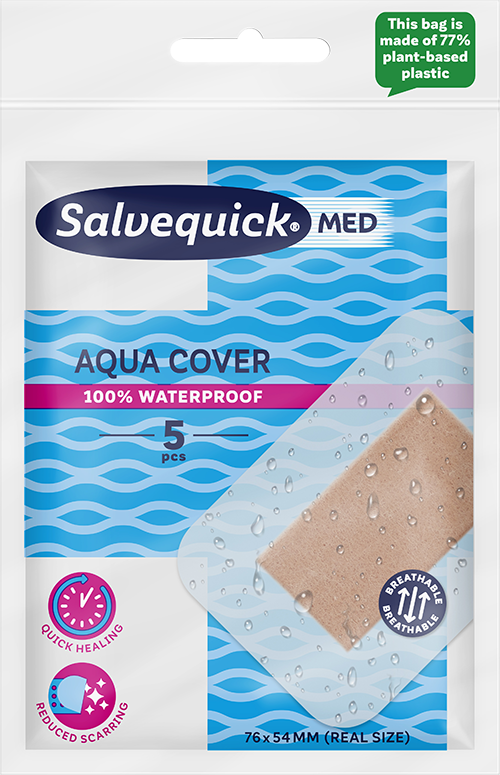Welcome to our global website
Or choose another language
Article
If you have a wound, it is important that you treat it correctly. The wound must be cleaned and should be kept moist and protected.
If you have a wound, it is important that you treat it correctly. The wound must be cleaned and should be kept moist and protected.

First, wash your hands and the skin around the wound to avoid dirt entering the wound. Then clean the wound by rinsing away dirt and bacteria under running lukewarm water with mild soap or with saline solution, or a wound cleansing fluid. Dry the skin around the wound and allow to dry in the air for a few minutes.

The next step is to protect the cleaned wound from dirt and bacteria with a plaster. Choose a plaster in a size that allows the wound pad to cover the whole wound. Ideally use a plaster that seals tightly all around the wound pad and thereby enables a moist wound healing. In a moist rather than a dry and airy healing environment, the healing processes accelerates, and the risk of scarring and infections is reduced.

Protect the wound with a plaster until the wound has healed completely, to allow it to heal without disturbance and to be protected from outside contamination. Change to a new plaster and clean the wound every day to make sure that the wound is healing properly and is not infected (if not advised otherwise by your doctor). Also change plaster if it gets dirty or wets through. It is normal for the area around the wound to be a little warm and inflamed to begin with but ensure that the wound is not infected.
The biggest myth about wound healing is that wounds should be exposed to the air so that they dry out. Therefore, many believe that they do not need a plaster when they have hurt themselves. However, this approach is not recommended.
Medical research has proven that wounds heal faster in a moist environment rather than in a dry and airy environment since new cells form more quickly in the moist environment, and that the risk of scar formation and infection is reduced*. In a moist environment the skin cells migrate faster which results in faster wound healing (up to twice as fast). Furthermore, there is no blocking of the wound cavity when the skin cells are migrating to cover the wound and thereby it reduces the risk of scarring. The environment also enables optimal conditions for the body cells to fight bacteria, thus the risk of infection is reduced.
In other words, moist wound healing conditions accelerates the wound healing process and reduce the risk of scar formation and infection. For the moist environment to be formed, it requires a tightly sealed plaster covering the wound. Use a plaster with a material that adheres well on all sides of the wound pad and that allows a balanced transmission of moist through the material. Also make sure the wound pad covers the whole wound.
*Winter GD. Formation of the Scab and the Rate of Epithelization of Superficial Wounds in the Skin of the Young Domestic Pig. Nature 1962; 193; 293-4
Salvequick’s Aqua Block plasters, Aqua Cover and Antibact Cover enable moist wound healing; they accelerate the wounds healing process, reduce the risk of scar formation and infection. In addition, they are completely waterproof and breathable. Antibact Cover is also antibacterial to reduce the risk of infection. These plasters and covers are suitable for most wounds and the toughest challenges, e.g., playing outside, exercising, showering, and swimming.
Advanced Wound Care
A 100 % waterproof plaster that accelerates the wound healing process and reduces the risk for de...
12 pcs
Advanced Wound Care
A 100 % waterproof wound dressing that accelerates the wound healing process and reduces the risk...
5 pcs
Advanced Wound Care
A 100 % waterproof wound dressing with an antibacterial agent in the compress to reduce the risk ...
5 pcs
During the wound healing process, the wound moves through different phases. Here are a simplified explanation three wound healing stages:

The inflammation phase begins the very second the wound occurs. First the damaged tissue turns red and becomes swollen and tender. White blood cells, the body’s defence cells, gather in the area. Red blood cells, fibrin and platelets form a seal over the wound. This phase continues for two to four days.

White blood cells begin to repair the damaged tissue. Cells from the skin divide to be able to grow over the damaged tissue while new blood vessels grow inside the new tissue. This takes from a few days to a few weeks depending on how large the wound is.

The final phase may continue for several months and in some cases up to a couple of years depending on the size of the wound. During this phase, the new tissue grows stronger. Blood vessels that are no longer needed disappear, making the scar lighter.



